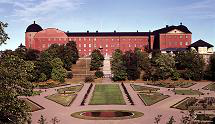Speaker
Ms
Li Caldeira Balkeståhl
(Uppsala University)
Description
for the PANDA collaboration.
The creation mechanism of quark-antiquark pairs and their arrangement to hadrons can be studied by measuring the reactions of the type antiproton+proton -> antibaryon+baryon. According to the Okubo-Zweig-Iizuka rule, all processes with disconnected quark lines are suppressed. By comparing several reactions involving different quark flavours the OZI rule, and its possible violation, can be tested for different levels of disconnected quark-line diagrams separately.
Furthermore, the parity violating weak decay of most ground state hyperons introduces an asymmetry in the distribution of the decay particles. As a consequence, the direction of flight of the decay products of the hyperon is related to the polarisation of the hyperon. This is quantified by the decay asymmetry parameter and gives access to spin degrees of freedom, e.g. the hyperon polarisation and the spin correlation of the hyperon and the antihyperon . One open question is how these observables related to the underlying degrees of freedom of the production mechanism.
All strange hyperons, as well as single charmed hyperons, are energetically accessible in the PANDA experiment at HESR, FAIR. A systematic investigation of these reactions will shed new light on single and multiple strangeness production and its dependence on spin observables. Above 2 GeV/c , PANDA will break new ground since no differential distributions and spin observables have been studied in this region so far. Simulations show that the differential cross sections as well as the spin observables can be well reconstructed with PANDA, both for strange- and single charmed hyperon channels. The results will be presented in this poster.
Primary author
Mr
Erik Thomé, for the PANDA Collaboration
(Uppsala University)
Co-author
Ms
Li Caldeira Balkeståhl
(Uppsala University)

